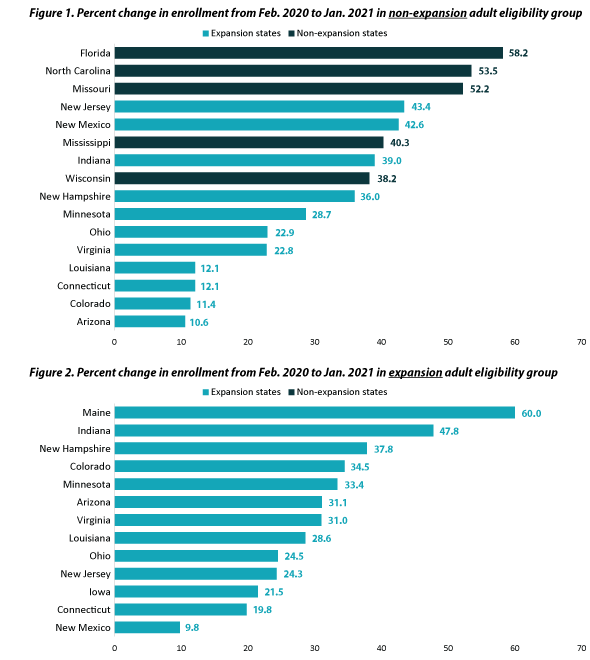Blog & News
Minnesota Medicaid Enrollment Grew More than the U.S. Average during COVID-19
July 21, 2021:The Minnesota Medicaid program has served as an important safety net program during the COVID-19 crisis. As a countercyclical program, Medicaid enrollment/spending increases when the economy is in decline (such as during a pandemic or a recession), as employer-sponsored insurance decreases and the low-income population increases.1
The additional enrollment of 166,364 individuals in Minnesota from February 2020 to January 2021 provided important and needed coverage during this unprecedented time.2 The COVID-19 public health emergency declaration has supported this growth with the moratorium on disenrollment and extended open enrollment sessions.
Medicaid in Minnesota
Minnesota was an early Medicaid expansion state through the options provided by the Affordable Care Act. Minnesota extended eligibility for Medicaid (called Medical Assistance in the state) to childless adults at or below 75% of the Federal Poverty Guideline (FPG) in 2011 and adopted the full expansion to 138% FPG in 2014.3,4 In 2019, Medical Assistance in Minnesota provided health insurance coverage to approximately 13.1% of the state’s population.5
Minnesota’s Medicaid expansion was a crucial resource during the COVID-19 pandemic for those who lost their jobs and/or their employer-sponsored health insurance coverage. It is estimated that approximately 29,500 Minnesotans lost their private health insurance coverage between April 2020-July 2020.6 Despite these changes, data from the 2019 Minnesota Health Access Survey and the state’s 2020 Health Insurance Enrollment Survey show that Minnesota’s uninsured population has stayed relatively stable during COVID-19, with increases in Medicaid enrollment making up for some of the losses experienced in the private insurance market.6
Minnesota in Context
SHADAC analyzed a recently released 50-state review of Medicaid growth during COVID-19 from Manatt Health to explore how Medicaid enrollment in Minnesota during COVID-19 compares to the rest of the United States.1 Manatt Health utilized state-specific sources to gather data from February 2020 through January 2021. These data show that Minnesota’s Medicaid program has not only stabilized the state’s coverage landscape but has also grown at a faster pace than many other state Medicaid programs. A total of 21 states have reported data from February 2020 to January 2021, and they are included in this analysis.
Key Findings1
From February 2020 to January 2021, enrollment in Medical Assistance grew by 19.7 percent in Minnesota, from 844,467 to 1,010,831. This increase was higher than the national median growth rate of 14.5 percent in expansion states and 15.7 percent in non-expansion states.
Only 3 of the 21 states that provided Medicaid enrollment data for this time period experienced larger growth: Florida, Indiana, and Missouri. The highest percentage growth among states was 22.6% in Missouri, and the lowest growth was 8.2% in Tennessee.
When comparing Medicaid expansion adults with non-expansion adults, Minnesota saw a growth in enrollment of 33.4% vs 28.7%, respectively. Minnesota’s enrollment growth was above the median for reporting states for expansion adults (31.0%) but below the 37.1% median for non-expansion adults (Exhibits 1 and 2).1
Conclusion
While Minnesota’s Medicaid growth during COVID-19 has helped to offset private health insurance coverage losses and the state’s program has done well with respect to coverage relative to many other states, the eventual end of the federal public health emergency will bring with it an end to special emergency Medicaid rules such as the moratorium on disenrollment. The public health emergency’s mandate of continuous eligibility was vital in the growth of Medicaid as a safety net. As the economy continues to recover and the federal public health emergency concludes as soon as the end of the year, we should see an increase in employer-sponsored insurance and a decrease in Medicaid enrollment due to the countercyclical nature of the program. It will be important to track Medicaid enrollment as these emergency rules are phased out to evaluate the impact of returning to standard enrollment and retention practices.
Further Reading
Pandemic’s Impact on Health Insurance Coverage in Minnesota was Modest by Summer 2020. (Minnesota Department of Health, May 2021)
Tracking Medicaid Enrollment Growth during COVID-19. (State Health and Value Strategies, February 2021)
1 MACPAC. (June 2020) Considerations for countercyclical financing adjustments in Medicaid. https://www.macpac.gov/wp-content/uploads/2020/06/Considerations-for-Countercyclical-Financing-Adjustments-in-Medicaid.pdf.
2 State Health and Value Strategies. (2021, February 25). Tracking Medicaid enrollment growth during COVID-19 databook. https://www.shvs.org/wp-content/uploads/2020/10/Tracking-Medicaid-Enrollment-Growth-During-COVID-19-Databook_03.2021.xlsx
3 Minnesota Department of Human Services. (2018). Medicaid Matters: The impact of Minnesota’s Medicaid Program [DHS-7659-ENG 2-18]. https://www.leg.mn.gov/docs/2018/other/180391.pdf
4 Office of Rural Health and Primary Care. (April 2017). Public and individual health insurance trends in rural Minnesota: enrollment during implementation of the Affordable Care Act. Minnesota Department of Health. https://www.health.state.mn.us/facilities/ruralhealth/pubs/docs/2017enroll.pdf
5 State Health Compare. (2021). Health Insurance Coverage Type. State Health Access Data Assistance Center (SHADAC). http://statehealthcompare.shadac.org/map/11/health-insurance-coverage-type-by-total#8/27/21
6 Minnesota Department of Health. (May 2021). Pandemic’s impact on health insurance coverage in Minnesota was modest by summer 2020. https://www.health.state.mn.us/data/economics/docs/inscoverage2020.pdf










